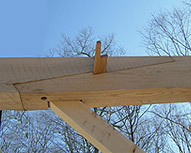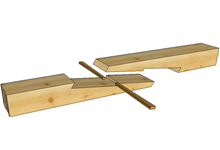Do you want BuboFlash to help you learning these things? Or do you want to add or correct something? Click here to log in or create user.
#has-images
Stopped-Splayed Wedged Scarf Joinery




As longer timbers became scarcer, early Americans developed various Scarf Joints to join two shorter timbers end to end to make one longer beam. All of our larger barns (30' or longer) utilize the Stopped-Splayed Wedged Scarf to create continuous Top Plates and Purlin Plates. This interesting joint is a significant improvement on a simple half lap and is well designed to resist tensile, compressive and shear forces in the beam.
If you want to change selection, open document below and click on "Move attachment"
New England Barn - Glossary of Joinery
We utilize a Mortise & Tenon joint at the corners to lock the sill timbers at right angles and a Mortise to receive a Tenon from the Corner Posts. As per modern building codes we also install pressure-treated 2x sills under the timbers. <span>Stopped-Splayed Wedged Scarf Joinery As longer timbers became scarcer, early Americans developed various Scarf Joints to join two shorter timbers end to end to make one longer beam. All of our larger barns (30' or longer) utilize the Stopped-Splayed Wedged Scarf to create continuous Top Plates and Purlin Plates. This interesting joint is a significant improvement on a simple half lap and is well designed to resist tensile, compressive and shear forces in the beam. Spline Joinery When two Girts (beams) are joined to a Post opposing each other at the same height, there is often not enough cross sectional width in the Post to allow for each Girt
New England Barn - Glossary of Joinery
We utilize a Mortise & Tenon joint at the corners to lock the sill timbers at right angles and a Mortise to receive a Tenon from the Corner Posts. As per modern building codes we also install pressure-treated 2x sills under the timbers. <span>Stopped-Splayed Wedged Scarf Joinery As longer timbers became scarcer, early Americans developed various Scarf Joints to join two shorter timbers end to end to make one longer beam. All of our larger barns (30' or longer) utilize the Stopped-Splayed Wedged Scarf to create continuous Top Plates and Purlin Plates. This interesting joint is a significant improvement on a simple half lap and is well designed to resist tensile, compressive and shear forces in the beam. Spline Joinery When two Girts (beams) are joined to a Post opposing each other at the same height, there is often not enough cross sectional width in the Post to allow for each Girt
Summary
| status | not read | reprioritisations | ||
|---|---|---|---|---|
| last reprioritisation on | suggested re-reading day | |||
| started reading on | finished reading on |
Details
Discussion
Do you want to join discussion? Click here to log in or create user.